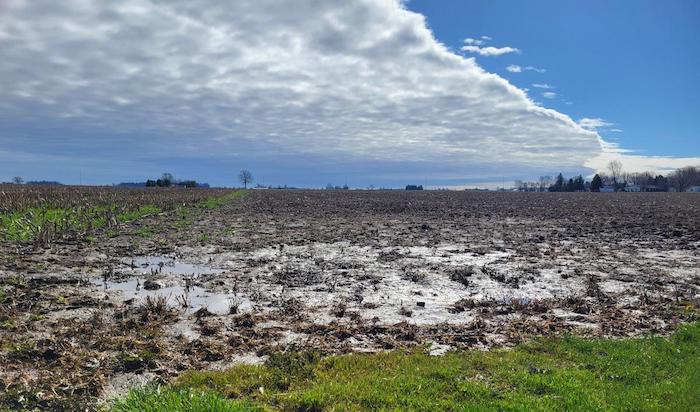The recent heavy rainfall events have implications on the fate of applied nitrogen (N). In the past 2 weeks, Ohio has received rainfall ranging from about 1.5 inches in the northwest to 6 inches in the central-eastern counties. Year to date, we are experiencing 2-8% higher rainfall than normal. N loss is exacerbated under such excessive rainfall scenarios via 3 pathways: runoff, leaching and denitrification.

OVERSATURATED SOIL. Higher than average rainfall in spring 2024 can cause flooding in fields and strip away nitrogen in the soil through runoff, leaching or denitrification. Source: Stephanie Karhoff/Ohio State University Extension
Runoff
The amount and intensity of rain received in the past week may have caused substantial soil erosion. Fields with no cover or residue are more susceptible to N runoff. If N fertilizer were applied recently in such fields, especially without incorporation into the soil, there is a high likelihood of N fertilizer being eroded out of the field.
Leaching
The nitrate form of N is liable to leach down the soil profile. Leaching is more prevalent in coarse textured soils than fine textured soils. In addition to the amount of rain, the amount of N loss via leaching will depend on:
Type of fertilizer used: Leaching loss of N depends on the amount of nitrate present in the soil. Fertilizers that contain N in the nitrate form such as UAN increase the chance of leaching loss because a large portion of UAN exists as nitrate form. According to Soil Fertility and Fertilizers: An Introduction to Nutrient Management by John Halvin et al., most of the anhydrous ammonia gets converted to nitrate in about 3-8 weeks, whereas 25% of UAN is in nitrate form on day 1 of application, and 100% of it is converted to nitrate within 1.25 to 2.5 weeks. Enhanced efficiency fertilizers that either include nitrification inhibitors or protective covering reduce the leaching potential by slowing the conversion of the source to the nitrate form.
Crop stage: If the field were bare, nitrate leaching potential could have been substantial. The presence of a cover crop or wheat during this time of the year can reduce nitrate leaching. The N uptake of wheat during the dormancy or early green up stage is minimal, thus making nitrate liable to leach down. If wheat was in stem elongation phase, nitrate leaching is less likely due to increased N uptake and prolific rooting system of wheat at this stage.
Denitrification
When soil is saturated with water during or after the rain event, N can be lost to the atmosphere via the denitrification process. The denitrification process refers to the conversion of nitrate form into gaseous forms (NOx or N2). The amount of N loss depends on how long soil stays saturated and soil temperatures during waterlogging, with warmer temperatures accelerating denitrification losses. Table 1 shows the potential loss of N due to denitrification under saturated soil conditions. For instance, Wooster received 2.41 inches of rainfall from March 30 to April 7. The maximum temperatures went above 55-degree F in 4 out of these 8 days. In addition, the daily maximum temperature will be above 60-degree F for most of this week (4/8/2024- 4/14/2024). Based on Table 1, if your field is still saturated from last week’s excessive rainfall, N loss can be above 25%.

NITROGEN LOSS. Soil conditions and temperature can affect how much or how quickly nitrogen (N) is lost from the soil. At higher temperatures, N loss is greater in a shorter amount of time than at lower temperatures. Source: University of Nebraska-Lincoln Extension
Strategic plan for N Management After Heavy Rains
If any of the above N loss mechanisms occurred in your field, especially after an N fertilizer application was made, it is important to supplement N to growing/upcoming crops to avoid yield losses. You can follow the given strategies below:
Estimate the N loss: The amount of N loss can be estimated based on the fertilizer type, time of application, crop growth stage and soil water content. Lentz and Culman (2015) outlined a procedure in this article: Concerns for N Loss in Corn from Recent Storms
Determine N in the soil: Pre-Sidedress Nitrogen test (PSNT) can be done to quantify the status of nitrogen in the soil. LaBarge (2022) outlined the procedure to decide if additional N would be needed in this article: Estimated and Soil Test Methods to Determine Supplemental N need after Flooding
Look out for plant N deficiency symptoms: Yellowing of lower leaves or inverted yellow V pattern on leaves could be a sign of N deficiency in crops. If such symptoms persist after soils are no longer waterlogged and temperatures are not on cooler end, it might be worthwhile to consider side-dressing N. You could also utilize sensors to determine NDVI to calculate N fertilizer requirement. The description of some Apps is outline by Logan et al. (2018) in this article: Crop Nutrition Apps





